Related Research Articles

HMAS Barcoo (K375/F375/A245) was a River-class frigate of the Royal Australian Navy (RAN). One of twelve frigates constructed in Australia during World War II, Barcoo, was laid down by Cockatoo Docks & Engineering Company, Sydney in 1942, and commissioned in early 1944.
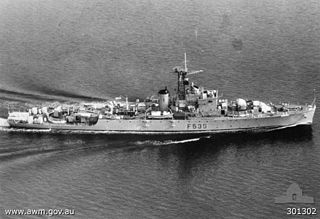
HMAS Shoalhaven (K535/M535/F535), named for the Shoalhaven River in New South Wales, was a modified River-class frigate of the Royal Australian Navy. She was laid down by Walkers at Maryborough on 18 December 1943, launched on 14 December 1944 by Senator Dorothy Tangney and commissioned at Urangan Pier in Hervey Bay in Queensland on 2 May 1946. Her first commander was Commander Rodney Rhoades.

HMAS Echuca (J252/M252), named for the town of Echuca, Victoria, was one of 60 Bathurst-class corvettes constructed during World War II, and one of 36 initially manned and commissioned by the Royal Australian Navy (RAN).

HMAS Stawell (J348/M348) was a Bathurst-class corvette named for the town of Stawell, Victoria. Sixty Bathurst-class corvettes were constructed during World War II, and Stawell was one of 36 initially manned and commissioned solely by the Royal Australian Navy (RAN).

HMAS Supply was a Tide-class replenishment oiler of the Royal Fleet Auxiliary (RFA) and the Royal Australian Navy (RAN). Originally named Tide Austral and intended to be the first ship of a post-World War II Royal Australian Fleet Auxiliary, manpower and financial shortages meant that when the Belfast-built ship was launched in 1955, she could not be accepted into Australian service. Instead, she was loaned to the RFA, operating RFA Tide Austral (A99). In August 1962, the ship was commissioned directly into the RAN, then renamed a month later to HMAS Supply. Supply operated as part of the RAN until her decommissioning at the end of 1985.
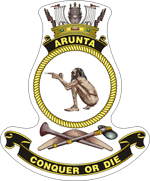
HMAS Arunta (I30/D5/D130) was a Tribal-class destroyer of the Royal Australian Navy (RAN). Named for the Arrernte Aboriginal peoples, the destroyer was laid down in 1939 and commissioned into the RAN in 1942.
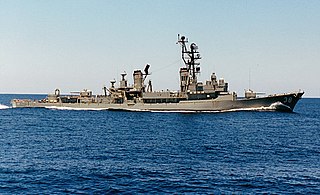
The Perth-class destroyers were three modified Charles F. Adams-class guided missile destroyers operated by the Royal Australian Navy (RAN). Ordered from Defoe Shipbuilding Company during 1962 and 1963, HMA Ships Perth, Hobart, and Brisbane were the first guided missiled-armed warships, and the first naval ships of United States design, to enter service with the RAN. All three ships operated during the Vietnam War, while Brisbane also participated in the Gulf War. The class was decommissioned between 1999 and 2001, with all three vessels later sunk as dive wrecks.

HMS Black Prince was a Dido-class light cruiser of the Royal Navy, of the Bellona subgroup. The cruiser was commissioned in 1943, and served during World War II on the Arctic convoys, during the Normandy landings, and as part of the British Pacific Fleet. In 1946, the cruiser was loaned to the Royal New Zealand Navy, becoming HMNZS Black Prince. The cruiser was docked for modernisation in 1947, but in April, her sailors walked off the ship as part of a series of mutinies in the RNZN. The shortage of manpower resulting from these mutinies meant that the modernisation had to be cancelled, and Black Prince was placed in reserve until 1953. She returned to service after refitting with simplified secondary armament with a single quad "pom pom" in Q position and eight Mk3 40mm Bofors guns. The ship was decommissioned again two years later, and returned to the Royal Navy in 1961. Black Prince did not re-enter service, and was towed from Auckland to Osaka for scrapping in 1962.

HMAS Success was an Admiralty S-class destroyer of the Royal Australian Navy (RAN). Built for the Royal Navy during World War I, the ship was not completed until 1919, and spent less than eight months in British service before being transferred to the RAN at the start of 1920. The destroyer's career was uneventful, with almost all of it spent in Australian waters. Success was decommissioned in 1930, and was sold for ship breaking in 1937.
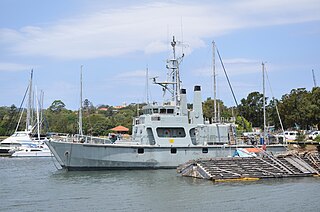
The Bay-class Minehunter Inshores were a class of catamaran-hull mine warfare vessels operating with the Royal Australian Navy from 1986. Also referred to as the MHCAT, the class was an attempt to produce a locally designed inshore mine warfare vessel. Two prototype ships were ordered in 1981, with the first ship, Rushcutter, commissioned in November 1986. The two ships experienced delays in construction, and the RAN resorted to acquiring six minesweeper auxiliaries (MSA) under the Craft of Opportunity Program to provide an interim mine-warfare capability, while also keeping Ton-class minesweeper HMAS Curlew in service until 1990, well beyond her intended decommissioning date. The ships did not enter service until 1993, due to problems with the sonar.
HMAS Huon is a former Royal Australian Navy (RAN) base located in Hobart, Tasmania, Australia, in operation from 1911 to 1994.
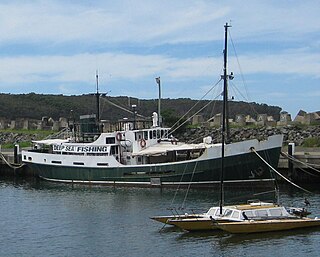
HMAS Banks was an Explorer class general-purpose vessel of the Royal Australian Navy (RAN), serving in a range of capacities from 1960 until 1995. She was named in honour of Sir Joseph Banks, the botanist aboard HM Bark Endeavour during the discovery of the eastern coast of Australia in 1770.

HMAS Stalwart (H14) was an Admiralty S class destroyer of the Royal Australian Navy (RAN). Built for the Royal Navy during World War I, the ship was not completed until 1919, and spent less than eight months in British service before being transferred to the RAN at the start of 1920. The destroyer's career was uneventful, with almost all of it spent operating along the east coast of Australia. Stalwart was decommissioned at the end of 1925, was sold for ship breaking in 1937, then was scuttled in 1939.

HMS Sealark was a Royal Navy vessel used primarily for hydrographic survey work. She was originally a luxurious private auxiliary steam yacht for a number of wealthy owners and in 1903 was acquired by the Royal Navy, serving until 1914. She was sold to James Patrick Steamships Ltd and converted to a merchant ship for the Australian coast and finally hulked in 1924.
HMCS Spitfire was a 65-ton sail gunboat built at Cuthberts Shipyard, Port Jackson, Australia and launched on 3 April 1855 for the Colony of New South Wales. Her hull was sheathed with 22-ounce copper. She was the first warship built in Australia for a Colonial government. Spitfire was given to the Colony of Queensland in 1859 and she was used as the pilot cutter on Moreton Bay. In 1860, she was used as part of an expedition to find the mouth of the Burdekin River. She was to become the pilot boat for Cooktown, until sold out of service in 1885 and purchased by Captain Alex Mathewson, for use as a fishing vessel. She was sold in 1892 to Dan Moynahan and S.B. Andreassen and during a cyclone in 1896 she was damaged off Hinchinbrook Island.

TB 191 was a second-class torpedo boat constructed for the Colony of Tasmania and later operated by the Commonwealth Naval Forces and the Royal Australian Navy. She was sold in 1911.
Murex was a 3,564 gross ton M class oiler, built by William Gray & Company, West Hartlepool in 1892 for Marcus Samuel & Company. She was the first bulk-oil tanker to pass through the Suez Canal en route to Thailand in 1892. She was chartered by the Royal Australian Navy and took part in operations against the German colonies in the Pacific with the Australian Naval and Military Expeditionary Force during the First World War in 1914, as an oiler. Murex was given the battle honour "Rabual 1914", for her service. She was later requisitioned by the Admiralty.

Whangape was a cargo ship measured at 2,931 gross register tons (GRT), built in 1899 by Sir Raylton Dixon & Co., Middlesbrough. The vessel was constructed for the British Maritime Trust as Adriana, sold while on the slips to Elder, Dempster & Company and renamed Asaba. Her engine was built by T Richardson & Sons, Hartlepool.
HMAS Coogee was a passenger ferry that briefly served as a Royal Australian Navy armed patrol vessel and minesweeper in the latter part of the First World War. She was launched in 1887 and scuttled in 1928.

HMAS Bass was an Explorer class general-purpose vessel of the Royal Australian Navy (RAN), serving in a range of capacities from 1960 until 1994.
References
- Gillett, Ross (1986). Australia's navy : past, present & future. Brookvale, NSW: Child & Henry. ISBN 0-86777-178-X.
- Odgers, George (1982). The Royal Australian Navy : an illustrated history. Brookvale, NSW: Child & Henry. ISBN 0-86777-240-9.